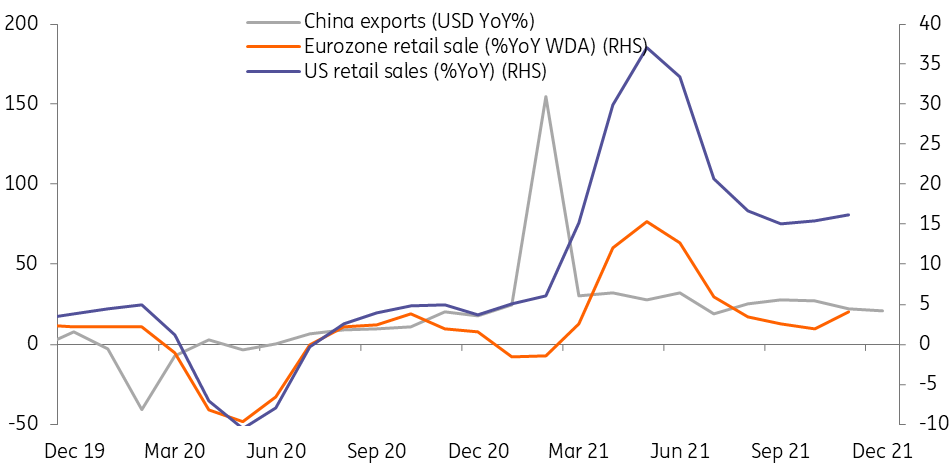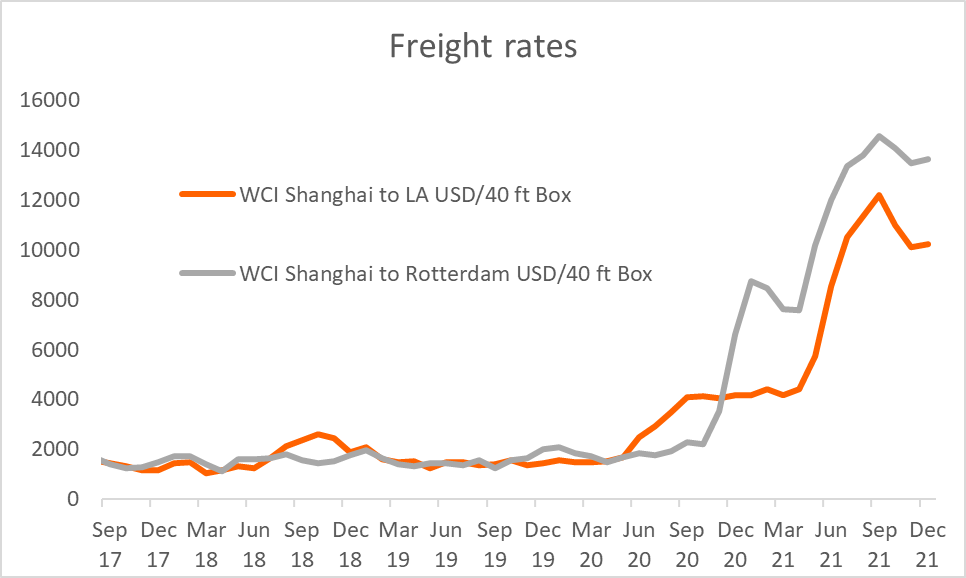Stronger China trade expected in 2022
As the global economy recovers, we should see stronger demand for goods, and therefore stronger international trade in China. The challenges will continue to be freight delays and semiconductor shortages
ASEAN is the biggest trade partner in 2021
The China trade surplus was $676.2bn in 2021, an increase of 29% from 2020. December had the largest trade surplus of $94.5bn.
For the whole of 2021, ASEAN became China's biggest trade partner, followed by the European Union, then the US. This shows that Asia as a whole is now integral to the manufacturing supply chain, though it is also true that domestic demand from ASEAN is growing.
In terms of export products, steel increased the most at 80%, electronics, which is the largest in terms of value, rose near 30%. For imports, coal rose near 77% while the largest item, electronics, rose 20%.
Overall, this shows that China is still a very important manufacturing location for electronics.
Prospects in 2022
We believe that as the global economy continues to improve, there will be more demand for goods. This implies more international trade for China in 2022. Continued semiconductor shortages will be a challenge for manufacturers and exporters of many goods, from refrigerators to vehicles, not to mention smartphones and gadgets. This is not going to be solved instantly. As such, prices of these goods will either have to go up or the quality or functionality may have to come down.
Coal imports into China were strong in 2021. This could extend into 2022 before China beefs up its solar and wind power to replace coal. But bear in mind that China's roadmap is to have peak carbon emissions in 2030 before reducing them from there, to reach carbon zero by 2060. So, before 2030 we may continue to see a high volume of coal imports into China as China also starts to close down dirty coal processing lines.
Demand from EU and US lead China exports
The lag indicates the shipment time

Covid could attack the ports from time to time
We have already seen how port operations can be affected due to workers catching Covid. We can't rule out more disruption in 2022. But this is not just a China problem, it's a worldwide problem. When either side of the freight line is suspended, even for a few days, freight rates rise and so does the cost of shipments.
This could be a potential factor for inflation. But we don't think this will derail trade growth in 2022.
High freight rates

A stable yuan is positive for trade
Exporters may not need to worry too much on the exchange rate risk in 2022 as the central bank has made clear that the yuan exchange rate should be stable for the year.
This should reduce the risk and the cost of hedging, which is good news for exporters. We forecast the USD/CNY to reach 6.5 by the end of 2022.
"THINK Outside" is a collection of specially commissioned content from third-party sources, such as economic think-tanks and academic institutions, that ING deems reliable and from non-research departments within ING. ING Bank N.V. ("ING") uses these sources to expand the range of opinions you can find on the THINK website. Some of these sources are not the property of or managed by ING, and therefore ING cannot always guarantee the correctness, completeness, actuality and quality of such sources, nor the availability at any given time of the data and information provided, and ING cannot accept any liability in this respect, insofar as this is permissible pursuant to the applicable laws and regulations.
This publication does not necessarily reflect the ING house view. This publication has been prepared solely for information purposes without regard to any particular user's investment objectives, financial situation, or means. The information in the publication is not an investment recommendation and it is not investment, legal or tax advice or an offer or solicitation to purchase or sell any financial instrument. Reasonable care has been taken to ensure that this publication is not untrue or misleading when published, but ING does not represent that it is accurate or complete. ING does not accept any liability for any direct, indirect or consequential loss arising from any use of this publication. Unless otherwise stated, any views, forecasts, or estimates are solely those of the author(s), as of the date of the publication and are subject to change without notice.
The distribution of this publication may be restricted by law or regulation in different jurisdictions and persons into whose possession this publication comes should inform themselves about, and observe, such restrictions.
Copyright and database rights protection exists in this report and it may not be reproduced, distributed or published by any person for any purpose without the prior express consent of ING. All rights are reserved.
ING Bank N.V. is authorised by the Dutch Central Bank and supervised by the European Central Bank (ECB), the Dutch Central Bank (DNB) and the Dutch Authority for the Financial Markets (AFM). ING Bank N.V. is incorporated in the Netherlands (Trade Register no. 33031431 Amsterdam).
